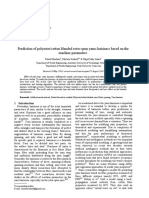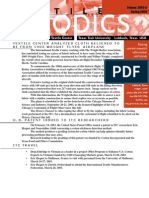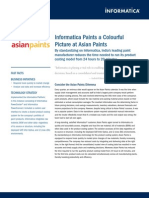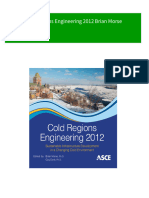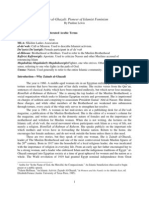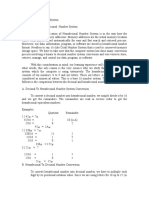Analysis of The Imperfection Index (Ipi) Value of Carded Yarn Produced by Using Different Diameter Spacers On The Ring Frame Spinning Machine
Analysis of The Imperfection Index (Ipi) Value of Carded Yarn Produced by Using Different Diameter Spacers On The Ring Frame Spinning Machine
Uploaded by
Utsho ParvezCopyright:
Available Formats
Analysis of The Imperfection Index (Ipi) Value of Carded Yarn Produced by Using Different Diameter Spacers On The Ring Frame Spinning Machine
Analysis of The Imperfection Index (Ipi) Value of Carded Yarn Produced by Using Different Diameter Spacers On The Ring Frame Spinning Machine
Uploaded by
Utsho ParvezOriginal Title
Copyright
Available Formats
Share this document
Did you find this document useful?
Is this content inappropriate?
Copyright:
Available Formats
Analysis of The Imperfection Index (Ipi) Value of Carded Yarn Produced by Using Different Diameter Spacers On The Ring Frame Spinning Machine
Analysis of The Imperfection Index (Ipi) Value of Carded Yarn Produced by Using Different Diameter Spacers On The Ring Frame Spinning Machine
Uploaded by
Utsho ParvezCopyright:
Available Formats
ONLINE INTERNATIONAL CONFERENCE ON ICMRD-21
MULTIDISCIPLINARY RESEARCH & DEVELOPMENT Online
ANALYSIS OF THE IMPERFECTION INDEX (IPI) VALUE OF CARDED YARN
PRODUCED BY USING DIFFERENT DIAMETER SPACERS ON THE RING
FRAME SPINNING MACHINE
1
Abdullah Al Parvez, 2Pranay Dutta, 3Md. Imranul Shahid, 4MD Abdullah Akib
Student, Department of Textile Engineering, Bangladesh University of Textiles1 3 4
Instructor, Department of Textile Technology,Chittagong Technical College, Chattogram, Bangladesh2
parvezctec@gmail.com1, pranaydutta992@gmail.com2, alvee096.ctec71@gmail.com3, akib465@gmail.com4
ABSTRACT
One of the significant parameters of yarn is the Imperfection Index (IPI). This IPI value can be
controlled using different diameter spacers because the spacer diameter makes a massive difference in yarn
production. Imperfection Index represents whether the produced yarn has good strength, fineness, and
appearance or not. That is why Imperfections have a decisive influence on the utility and market value of
yarn. This research is primarily aimed at not only how to curb the Imperfection Index using different spacers
of different diameters but also to see how various diameters of the spacer have a relatively good influence
on controlling yarn imperfections. In the experiment, Ne 30/1 carded yarn was produced each time using
three different spacers. The test specimens have been examined by using a USTER TESTER 5. Then, the
properties of the generated yarns were compared to analyze the spacer diameter's effect on the
characteristics of the yarn in the ring frame. The best result has been obtained from this experiment using a
low diameter spacer, which is a yellow color spacer with a diameter of 2.2 mm. Hence, we concluded that
Imperfection Index would be high if we use a high-diameter spacer
Keywords: Imperfection Index, Ring frame, IPI, Uster Tester, Spacer.
INTRODUCTION
The textile industry is mainly associated with the manufacture of yarn and cloth, Where “Yarn is a material
of considerable length and a comparatively limited cross-section consisting mainly of fibers or filaments with or
without twisting” [1]. In addition, yarn manufacturing is the first stage of textile processing that converts the
fibers into yarns. It is one of the subsections of backward linkage of clothing industries. The yarn can be
classified based on spinning techniques such as ring, compact, rotor, air-jet, and friction. Nowadays, ring
spinning is mostly used because of its simplicity, flexibility, and economics in commercial production. Since
industrialization, the ring-spinning method has been commonly used to produce yarn because there are major
benefits available in this method. It is a widely applicable method by which yarn of any desired fineness with
optimum characteristics, particularly about structure and strength, can be generated [2]. Approximately 90
percent of the world's spinning industry uses ring spinning to allow it the most prominent short-staple fiber
process [3].
Furthermore, it is essential to produce yarn without any fault. Indeed, some major parameters are mainly
responsible for several yarn faults, such as Imperfection index (IPI), Coefficient of variation of mass (CV %),
Hairiness index, Periodic defects, Classimate faults. The imperfection of yarn is known as one of the most major
factors as it has a major influence on the yarn properties. Moreover, Imperfections can be defined as the total
number of neps, thick and thin places in a given length of yarn. Imperfection, a common fault of yarn, is known
for thin, thick places and neps in 1000 meters of yarn. Evenness Tester, namely Uster Tester 5, is required to
www.iejrd.comSJIF: 7.169 1
Organized By Manav Knowledge City http://mkct.org.in/icmrd/
ONLINE INTERNATIONAL CONFERENCE ON ICMRD-21
MULTIDISCIPLINARY RESEARCH & DEVELOPMENT Online
calculate the IPI of yarns with the results of different yarn evenness parameters. Thin and thick places refer to
imperfections within the measuring sensitivity range (±50% with respect to the mean value of cross-sectional
yarn size), while neps are classified as the yarn imperfections which may exceed the 200% limit [4]
Figure 1: Imperfection Index of yarn [5]
Additionally, there are some reasons for which the yarn imperfection index may increase(Shaikat, 2021):
With the increase in break draft, the yarn imperfection increases.
The yarn imperfection also increases due to the increasing roving twist multiplier for the same yarn
count.
Fibre rupture is critical that significantly affects yarn quality and processability. Fiber rupture will have
a huge impact on imperfections and irregularity in the yarn.
The blow room stage's efficient opening improves fiber cleaning and yarn properties such as yarn
tenacity and total imperfections.
The increase in imperfections at higher openness is due to overbeating than that which is necessary.
The yarn unevenness and imperfections increase with the increase in card production rate.
The increase in the card's delivery speed will substantially increase the sliver's unevenness and
imperfections. Incorrect brake draft increases yarn U%, imperfections, and neps.
Yarn imperfections and hairiness index increase with the thicker lap.
Yarn imperfections have an increasing trend with an increase in the feed amount.
Sharieff and Vinzanekar said that „For ring-spun yarn, imperfections adversely affect yarn and fabric
quality. A yarn with far more imperfections may show worse grade quality, poorer weight, and poor knitting
efficiency is likely to yield a low-quality fabric. A buyer should have a decent idea about the imperfection index
value of their required yarn; otherwise, they will have to suffer a lot in the imminent procedure of textile product
production. The fair idea is to avoid so many major problems between different production sections like
knitting, dyeing, and even in the spinning section; on the other hand, the knitting section will face several issues,
such as yarn's breakage during knitting fabric. The dyeing section mostly meets shade variation on dyed fabric,
which eventually becomes the main reason for the significant loss of a particular company. That is why we
report here how to control the imperfections index using different spacers of different diameters and tests them
by using USTER TESTER 5 and also to see how different diameters spacer has a relatively good influence on
controlling yarn imperfections.
METHODS AND MATERIALS
Materials
30 Ne carded yarn was used for the test, and 30/1 carded yarn is produced in the ring frame machine
using three different diameter spacers. Our experiment's raw product is produced using 100% cotton, collected
www.iejrd.comSJIF: 7.169 2
Organized By Manav Knowledge City http://mkct.org.in/icmrd/
ONLINE INTERNATIONAL CONFERENCE ON ICMRD-21
MULTIDISCIPLINARY RESEARCH & DEVELOPMENT Online
from the African country Mali. The table indicates the general properties and parameters of the fibers of that
cotton which was assessed by the Uster- HVI instrument at the standard testing condition.
Table 1: Properties of tested cotton fibers
Spinning Short
Quality Mic Uniformity
Consistency Maturity Length (mm) Fibres
parameters (μg/inch) Index
Index Index (%)
Value 126 4.29 0.88 28.46 81.3 8.0
Quality Elongation Moisture Reflectance Yellowness Trash Strength
parameters (%) (% ) (%) (+b) content (gm/Tex)
Value 3.3 7.0 72.8 10.0 0 30.9
Machine and Parts
Ring Frame
The ring frame of Cetex “Laboratory Spinning Unit LSE 2000” was used in the experiment. The best three
performing spindles were used for producing the required 30‟s card yarn.
Table 2: Parameters of the ring frame
Spindle speed 15000 rpm
Roller setting 45x65 mm
TPM 750
Compact device EliTeR
Drafting device 3-over-3
Spacer
The spacer is the element that determines the distance between the apron and the bottom apron at which the
short fibers are primarily governed [6]. We set up three different diameter‟s Spacer for three different particular
spindles to get three distinct samples for the experiment.
Table 3: Spacer Diameter (mm)
Color Yellow Violet White
Diameter 2.2 2.5 2.8
Figure 2: Spacer of different diameters
Uster Tester-5
Here, Uster Tester-5 was used to determine the yarn's unevenness and imperfection index at a speed of
400 m/min. The experimental parameters were CVm%, thin places (-50%), thick places (+50%), neps (+280%),
and hairiness which is assessed by Uster tester 5. Yarn diameter can be calculated by the capacitive method.
www.iejrd.comSJIF: 7.169 3
Organized By Manav Knowledge City http://mkct.org.in/icmrd/
ONLINE INTERNATIONAL CONFERENCE ON ICMRD-21
MULTIDISCIPLINARY RESEARCH & DEVELOPMENT Online
Methods
For the test, we took three different carded (KH) yarn samples produced from the ring frame machine,
and each type of sample has ten specimens of 1000m length, which we got from the ring machine by using
different diameter spacer. One by one, all testing specimens were passed through the Uster tester machine so
that we could get our required values for our projected work, such as Thick%, Thin%, Neps% according to yarn
diameter.
The whole test is done by The USTER TESTER 5, where the yarn is passed through two capacitive plates,
and on the basis of capacitance changes, the diameter of the yarn passing through the plates is analyzed.
Figure 3: OM sensor of Uster 5 [7]
For each color diameter spacer, separate ten, length of 1000m, specimen was taken for conducting the
test.
Suppose the diameter of any specific portion along the length of the yarn shows a value +50% more
than the actual diameter of that particular place (selected before by requirement). In that case, those increased
places of diameter are counted as the Thick Place of yarn. This is how ten specimens (produced by a specific
diameter spacer out of three, for example, white color spacer) of 1000 m long carded ring yarn were passed
through the Uster Machine to get an average value of yarn thick places percentage. Again if the diameter of any
specific position of the Yarn is less than 50%, we can say -50% thin places, which means the yarn diameter is
decreased than the actual diameter is denoted as Thin Places of Yarn. The same as if the percentage of some
specific place‟s diameter of the yarn is more than 200% and another condition is if those places were 3mm long,
then such places are considered neps of the yarn. The number of (+280%) neps per 1000 meters of the tested
yarns is considered instead of +200% neps for rotor spun yarns, Where +280% neps indicates the cross-section
at the nep is 280% of the mean cross-section of the yarn or more. This is how the main calculation conducted by
Uster tester 5, which is the primary data to examine the IPI of a yarn lot, and we mainly get our required IPI
values by the summation of the average value of testing yarn thick places percentage, thin places, and neps
percentages. One thing we should know that the greater the value of the IPI we will found, the lower will be the
evenness of that yarn and vice versa. So, we can say that a lower IPI value represents good quality yarn.
RESULTS AND DISCUSSIONS
After testing the required specimen in the Uster tester machine, bellows reports are found.
For Yellow Color Spacer
www.iejrd.comSJIF: 7.169 4
Organized By Manav Knowledge City http://mkct.org.in/icmrd/
ONLINE INTERNATIONAL CONFERENCE ON ICMRD-21
MULTIDISCIPLINARY RESEARCH & DEVELOPMENT Online
Table 4: Imperfection properties of yellow color spacer (for 2.2 mm)
Thin Thin Thin Thick Thick Neps Neps Rel. Cnt
Sample ±
U% -30% -40% -50% +35% +50% +200% +280%
No.
/km /km /km /km /km /km /km %
1 12.22 3330 347.5 7.5 1323 247.5 175.0 22.5 -5.7
2 12.27 3090 340.0 10.0 1225 217.5 157.5 27.5 -3.5
3 11.66 2740 275.0 10.0 1075 232.5 172.5 35.0 -3.6
4 12.07 2958 250.0 2.5 1210 242.5 182.5 20.0 -2.0
5 11.91 3045 307.5 7.5 1295 282.5 172.5 45.0 -2.7
6 11.45 2273 165.0 5.0 1038 155.0 145.0 30.0 6.6
7 11.85 2480 212.5 10.0 1228 262.5 190.0 35.0 1.6
8 11.75 2670 297.5 12.5 1075 207.5 132.5 12.5 -1.6
9 11.47 2068 165.0 2.5 920 165.0 137.5 10.0 7.9
10 11.80 2586 262.5 5.0 1163 245.0 150.0 27.5 3.0
Mean 11.85 2724 262.3 7.0 1155 225.8 161.5 26.5 0.0
Therefore, for this yellow colour Spacer, the average value of ten test specimen of 1000 m long yarn is (-
50%) thin places is 7.0, (+50%) thick places is 225.8, and the neps (+200%) is 161.5, and summation of all three
value are representing the IPI value for the test sample of the yellow colour spacer is 394.6 (7.0 + 225.8 + 161.5
= 394.6)
For Violet Color Spacer
From the table 5, for this violet color spacer, the average value of ten test specimen of 1000 m long yarn is
(-50%) thin places is 13.5, (+50%) thick places is 277.3, and the neps (+200%) is 163.5, and summation of all
three value are representing the IPI value for the test sample of the violet color spacer is 454.3 (13.5 + 277.3 +
163.5 = 454.3)
Table 5: Imperfection properties of violet color spacer (for 2.5 mm)
Thin Thin Thin Thick Thick Neps Neps Rel. Cnt
Sample ±
U% -30% -40% -50% +35% +50% +200% +280%
No.
/km /km /km /km /km /km /km %
1 12.35 3163 392.5 15.0 1403 322.5 217.5 12.5 -1.0
2 12.18 3120 285.0 7.5 1408 347.5 190.0 40.0 -0.3
3 12.53 3595 455.0 25.0 1545 352.5 205.0 55.0 -3.3
4 11.97 2845 332.5 5.0 1255 222.5 147.5 37.5 -0.1
5 11.78 2600 230.0 10.0 1125 190.0 117.5 25.0 3.7
6 12.32 3443 415.0 20.0 1530 362.5 217.5 25.0 -3.7
www.iejrd.comSJIF: 7.169 5
Organized By Manav Knowledge City http://mkct.org.in/icmrd/
ONLINE INTERNATIONAL CONFERENCE ON ICMRD-21
MULTIDISCIPLINARY RESEARCH & DEVELOPMENT Online
7 12.11 3368 292.5 17.5 1305 227.5 122.5 22.5 -3.0
8 11.64 2428 215.0 7.5 1125 232.5 137.5 30.0 6.1
9 11.84 2733 285.0 17.5 1215 247.5 100.0 20.0 4.2
10 12.16 3075 320.0 10.0 1268 267.5 180.0 35.0 -2.5
Mean 12.09 3037 322.3 13.5 1318 277.3 163.5 30.3 0.0
For White Color Spacer
Table 6: Imperfection properties of white color spacer (for 2.8 mm)
Thin Thin Thin Thick Thick Neps Neps Rel. Cnt
Sample ±
U% -30% -40% -50% +35% +50% +200% +280%
No.
/km /km /km /km /km /km /km %
1 12.53 3535 465.0 15.0 1640 345.0 225.0 40.0 -1.1
2 12.52 3523 450.0 22.5 1563 305.0 172.5 12.5 -1.0
3 12.14 3168 327.5 10.0 1445 337.5 212.5 35.0 0.4
4 12.52 3308 382.5 7.5 1390 310.0 225.0 35.0 1.3
5 12.30 3183 387.5 10.0 1403 290.0 170.0 30.0 5.9
6 12.31 3253 372.5 5.0 1380 300.0 197.5 27.5 0.7
7 12.92 4030 600.0 25.0 1695 450.0 257.5 50.0 -2.3
8 12.88 3930 475.0 17.5 1725 387.5 255.0 27.5 -1.4
9 12.51 3715 472.5 15.0 1610 407.5 217.5 60.0 -0.6
10 12.45 3723 462.5 20.0 1515 360.0 185.0 40.0 -1.9
Mean 12.51 3537 439.5 14.8 1537 349.3 211.8 35.8 -0.0
Hence, for this white color spacer, the average value of ten test specimen of 1000 m long yarn is (-50%)
thin places is 14.8, (+50%) thick places is 349.3, and the neps (+200%) is 211.8, and summation of all three
value are representing the IPI value for the test sample of the white color spacer is 575.9 (14.8 + 349.9 + 211.8 =
575.9).
Figure 3: IPI values for different diameter spacers
www.iejrd.comSJIF: 7.169 6
Organized By Manav Knowledge City http://mkct.org.in/icmrd/
ONLINE INTERNATIONAL CONFERENCE ON ICMRD-21
MULTIDISCIPLINARY RESEARCH & DEVELOPMENT Online
From the above three Spacer‟s results, we can understand that the yellow Spacer‟s sample has a better
IPI value than the other two spacers. From the results, another thing is cleared that the lower the diameter is, the
best will be the quality, evenness of the Carded Yarn. Less diameter spacer is responsible for less IPI value. On
the other hand, the worse sample is white color spacers yarn because its IPI is so high than the rest of the two
Spacer‟s samples.
CONCLUSIONS
We got three particular imperfection index values for each of the spacers in the experiment by using
three different size spacers in a ring spinning machine. From those results, we can conclude that the best result
has been obtained using a low diameter spacer, a Yellow colour spacer with a diameter of 2.2 mm, which
ultimately results in an almost minimum IPI value than the other two spacers. We know the Imperfection index
(IPI) values are directly related to the yarn evenness, and the less the number of IPI, the best will be the yarn
quality.
In this project work, we endeavor to discover how the IPI value of any particular Yarn, like Carded yarn,
can be controlled by using a different spacer, and in the end, we found the result. Furthermore, We can decide
that there‟s a significant correlation between spacer diameter and yarn imperfection index in a ring spinning.
REFERENCES
[1]. M. Denton and P. Daniels, Textile Terms and Definitions, London: Textile Terms and Definitions,
2010-2011.
[2]. W. Klein, The technology of short staple spinning, London: The textile institute, 1995.
[3]. J. Hossen and S. Raian, "Effect of Lattice Apron Age on the Quality of Compact Ring-Spun
Yarns," Trends in Textile Engineering & Fashion Technology, pp. 348-357, 2018.
[4]. J. Ochola, J. Kisato, L. Kinuthia, J. Mwasiagi and A. Waithaka, "Study on the Influence of Fiber
Properties on Yarn Imperfections in Ring Spun Yarns," Asian Journal of Textile, pp. 32-43, 2012.
[5]. E. M. I. Shaikat, "Imperfection Index of Yarns (IPI) | Reasons for Increasing Imperfection Index
of Yarn," 31 01 2021. [Online]. Available: https://textilelearner.net/imperfection-index-of-
yarnsreasons-
forincreasing/?fbclid=IwAR0kvxxoSQpRXqU81jz68G5HJbBmaF_UX86goRaOvO3iwRGKccxjh
7eIMxI.
[6]. A. Bagwan, B. Singone and V. Patil, "Appropriate Selection of Spacers at Ring Frame: An
Effective Measure to Improve Yarn Quality and Productivity," International Journal on Textile
Engineering and Processes, vol. 1, no. 2, pp. 2395-3578, 2015.
[7]. S. Ibrahim, J. Militky, D. Kremenakova, and R. Mishra, “Characterization of yarn diameter
measured on different," RMUTP International Conference: Textiles & Fashion, pp. 3-4, 2012.
www.iejrd.comSJIF: 7.169 7
Organized By Manav Knowledge City http://mkct.org.in/icmrd/
You might also like
- Sri City CompaniesDocument20 pagesSri City CompaniesRajan NNo ratings yet
- Modern Cotton Spinning Machinery, Its Principles and ConstructionFrom EverandModern Cotton Spinning Machinery, Its Principles and ConstructionNo ratings yet
- Hook Study PDFDocument6 pagesHook Study PDFNessre Zeine60% (5)
- Full Judgment - Bob Hewitt Rape CaseDocument12 pagesFull Judgment - Bob Hewitt Rape CaseSundayTimesZA100% (2)
- Uster Analysis of Cotton/polyester Blended Spun Yarns With Different CountsDocument14 pagesUster Analysis of Cotton/polyester Blended Spun Yarns With Different CountsQuocHuynhNo ratings yet
- Evaluation of Real Yarn Diameter - Processing, Dyeing & Finishing - FeaturesDocument7 pagesEvaluation of Real Yarn Diameter - Processing, Dyeing & Finishing - FeaturesTrinhTruongNo ratings yet
- Research Regarding Uniaxial Tensile Strength of Nylon Woven Fabrics, Coated and Uncoated With SiliconeDocument11 pagesResearch Regarding Uniaxial Tensile Strength of Nylon Woven Fabrics, Coated and Uncoated With SiliconeSimulation CAENo ratings yet
- Ijftr434393 401Document10 pagesIjftr434393 401jayanttiwariNo ratings yet
- Ocholaand Mwasiagi 2012Document6 pagesOcholaand Mwasiagi 2012kahishasafwanasutaNo ratings yet
- Prediction of Polyester/cotton Blended Rotor-Spun Yarns Hairiness Based On The Machine ParametersDocument7 pagesPrediction of Polyester/cotton Blended Rotor-Spun Yarns Hairiness Based On The Machine ParametersRavi KumarNo ratings yet
- Knitting Faults Causes and Remedies of Knit FabricsDocument14 pagesKnitting Faults Causes and Remedies of Knit FabricsRavi KumarNo ratings yet
- A Detailed Study On Effective Floating Fibre Control in Ring Frame and Its Impact On Yarn QualityDocument7 pagesA Detailed Study On Effective Floating Fibre Control in Ring Frame and Its Impact On Yarn QualitysalmaNo ratings yet
- A Study The Effect of Modifications in Compact Spinning Machine On The Yarn Quality PropertiesDocument10 pagesA Study The Effect of Modifications in Compact Spinning Machine On The Yarn Quality PropertiesVaibhav SinghNo ratings yet
- Hairiness - I PDFDocument4 pagesHairiness - I PDFDurairaj.NNo ratings yet
- Knitting Faults Causesand Remediesof Knit FabricsDocument14 pagesKnitting Faults Causesand Remediesof Knit FabricsDivya SuryavanshiNo ratings yet
- Textile Center Analyzes Cloth Believed To Be From 1903 Wright Flyer AirplaneDocument8 pagesTextile Center Analyzes Cloth Believed To Be From 1903 Wright Flyer Airplaneapi-3733260No ratings yet
- 12156-Article Text-34778-1-10-20190629Document10 pages12156-Article Text-34778-1-10-20190629Krish JainNo ratings yet
- Comparative Analysis of Fabrics Made From Eli-TwisDocument5 pagesComparative Analysis of Fabrics Made From Eli-TwisMễro ĢANo ratings yet
- Six SigmaDocument6 pagesSix Sigmasayeef khanNo ratings yet
- Ijftr 38 (3) 223-229Document7 pagesIjftr 38 (3) 223-229Farrukh JamilNo ratings yet
- Effect of Machine Parameters On Knit FabDocument5 pagesEffect of Machine Parameters On Knit FablfomlfomNo ratings yet
- Measurement of Seam Puckering and Influence of Its Causes: Sandun Fernando Tss JayawardenaDocument7 pagesMeasurement of Seam Puckering and Influence of Its Causes: Sandun Fernando Tss JayawardenaIOSRJEN : hard copy, certificates, Call for Papers 2013, publishing of journalNo ratings yet
- Friction SpinningDocument8 pagesFriction SpinningVenkat Prasanna50% (2)
- Efficiency Losses Calculation and Identify Causes of Losses of Circular Knitting Machine During Knit Fabric ProductionDocument5 pagesEfficiency Losses Calculation and Identify Causes of Losses of Circular Knitting Machine During Knit Fabric ProductionabcindNo ratings yet
- End Breakage Control in OEDocument7 pagesEnd Breakage Control in OEadama spinningNo ratings yet
- AFISDocument11 pagesAFISmolepe6687No ratings yet
- Vinesh 3Document5 pagesVinesh 3ShuBham GoelNo ratings yet
- Analysis of Number of Yarn Breaks During Warping Process: Kushal N. Vashi, Mox C. Patel, Mayur C. PatelDocument8 pagesAnalysis of Number of Yarn Breaks During Warping Process: Kushal N. Vashi, Mox C. Patel, Mayur C. PatelJagdish RudaniNo ratings yet
- Effect of Twist On Yarn PropertiesDocument6 pagesEffect of Twist On Yarn Propertiesali4300136No ratings yet
- Blended Project (Cotton, Polyester, Flax)Document6 pagesBlended Project (Cotton, Polyester, Flax)Towfic Aziz KanonNo ratings yet
- Fabric ScienceDocument7 pagesFabric ScienceArshiya GuptaNo ratings yet
- Auto Coner Quality Improvement of YarnDocument8 pagesAuto Coner Quality Improvement of YarnTeka Weldekidan AbebeNo ratings yet
- Full Book TPSPDocument120 pagesFull Book TPSPDeenaNo ratings yet
- Final Research 2022 Eman Sakr InterDocument12 pagesFinal Research 2022 Eman Sakr Intereman sakrNo ratings yet
- 4989 14525 1 PBDocument7 pages4989 14525 1 PBPranob Halder BappyNo ratings yet
- Figure Out The Weight Loss Percentage of Three Thread Fleece Fabric Composed of Different Fibres For Abrasion On The Technical Back SideDocument5 pagesFigure Out The Weight Loss Percentage of Three Thread Fleece Fabric Composed of Different Fibres For Abrasion On The Technical Back SideMahabbat HossainNo ratings yet
- Study On Impacts of Spinning Process On Fiber CharacteristicsDocument6 pagesStudy On Impacts of Spinning Process On Fiber CharacteristicsNeelakandan DNo ratings yet
- Effects of Combed and Carded Yarn On Weft Knitted Finished Fabric QualityDocument7 pagesEffects of Combed and Carded Yarn On Weft Knitted Finished Fabric QualityvirtulianNo ratings yet
- Effect of Machine Parameters On Knit Fabric SpecificationsDocument5 pagesEffect of Machine Parameters On Knit Fabric SpecificationsGarmentLearnerNo ratings yet
- Fdocuments - in - Analysis of Rejected Ring Cops in Autoconer Winding MachineDocument49 pagesFdocuments - in - Analysis of Rejected Ring Cops in Autoconer Winding MachineAbel TayeNo ratings yet
- Importance of Spindle Speed in Ring Frame: Research Article ISSN: 2637-4595Document3 pagesImportance of Spindle Speed in Ring Frame: Research Article ISSN: 2637-4595Arif HasanNo ratings yet
- Object XMLDocumentDocument6 pagesObject XMLDocumentsitu_texNo ratings yet
- Measurement of Seam Puckering and in Uence of Its Causes: IOSR Journal of Engineering April 2014Document8 pagesMeasurement of Seam Puckering and in Uence of Its Causes: IOSR Journal of Engineering April 2014Trangg BiNo ratings yet
- Impact of Piecing Index On Combed Yarn QualityDocument4 pagesImpact of Piecing Index On Combed Yarn QualityEditor IJTSRD100% (1)
- 6650-Article Text-19343-1-10-20151128Document8 pages6650-Article Text-19343-1-10-20151128Mr AdibNo ratings yet
- Comparative Study On Ring, Rotor and Air-Jet Spun Yarn: Sharif AhmedDocument14 pagesComparative Study On Ring, Rotor and Air-Jet Spun Yarn: Sharif AhmedBithy PaulNo ratings yet
- QC in WeavingDocument42 pagesQC in WeavingFarrukh Jamil100% (4)
- Comparative Study On Ring, Rotor and Air-Jet Spun Yarn: Sharif AhmedDocument14 pagesComparative Study On Ring, Rotor and Air-Jet Spun Yarn: Sharif Ahmedgizex2013No ratings yet
- Uster Imperfections of 35% Cotton and 65% Polyester Blended Yarn For 40ne, 50ne and 60ne Ring Spun YarnDocument7 pagesUster Imperfections of 35% Cotton and 65% Polyester Blended Yarn For 40ne, 50ne and 60ne Ring Spun YarnGobu SKNo ratings yet
- Effect of Cotton Yarn Imperfection Index On CSPDocument4 pagesEffect of Cotton Yarn Imperfection Index On CSPInternational Journal of Innovative Science and Research TechnologyNo ratings yet
- Wang Controlledexperimentonyarn 2007Document14 pagesWang Controlledexperimentonyarn 2007Hatice HaticeNo ratings yet
- Field Technology Handbook - 2020 - V1.0Document757 pagesField Technology Handbook - 2020 - V1.0mostafa.akpbcNo ratings yet
- New Development of A Swatch Given by BuyerDocument11 pagesNew Development of A Swatch Given by BuyerNaimul Hasan0% (1)
- Approach Development For Surveillance Assistance: Spinning Mill ApplicationDocument13 pagesApproach Development For Surveillance Assistance: Spinning Mill ApplicationShoaib ArifNo ratings yet
- Seams and Sewing Thread Characteristics in Denim FabricDocument11 pagesSeams and Sewing Thread Characteristics in Denim FabricAhmed ArshadNo ratings yet
- USTER HVI 1000 Principles of Fiber TestingDocument9 pagesUSTER HVI 1000 Principles of Fiber TestingQuocHuynhNo ratings yet
- Study On Denim and Gabardine Twill Fabric Cover FactorDocument47 pagesStudy On Denim and Gabardine Twill Fabric Cover FactorAtik U Bhuiyan71% (7)
- Surveillance and Control of The Yarn Input Tension On Circular Weft Knitting Machines: New ApproachesDocument7 pagesSurveillance and Control of The Yarn Input Tension On Circular Weft Knitting Machines: New ApproachesDarsNo ratings yet
- Yarn Clearing SystemsDocument11 pagesYarn Clearing SystemsLohit MohapatraNo ratings yet
- Ijartex 296Document14 pagesIjartex 296Krish JainNo ratings yet
- Sizzlers & BBQDocument13 pagesSizzlers & BBQchefixonlineNo ratings yet
- Solution: Problem Set No. Title: Strain Page No.Document5 pagesSolution: Problem Set No. Title: Strain Page No.Noven VillaberNo ratings yet
- United States v. Lionel Marquez, 909 F.2d 738, 2d Cir. (1990)Document7 pagesUnited States v. Lionel Marquez, 909 F.2d 738, 2d Cir. (1990)Scribd Government DocsNo ratings yet
- SLCM Esop Summary Notes by RS AcademyDocument3 pagesSLCM Esop Summary Notes by RS AcademyRaghavNo ratings yet
- Arc For CCTV Set With Television For Amul Booth in Delhi & NCRDocument10 pagesArc For CCTV Set With Television For Amul Booth in Delhi & NCRKhushagra The Music LegendNo ratings yet
- Unit 8 - CELEBRATIONS - Image.MarkedDocument11 pagesUnit 8 - CELEBRATIONS - Image.MarkednhiNo ratings yet
- BPI v. Casa MontessoriDocument2 pagesBPI v. Casa MontessoriReymart-Vin MagulianoNo ratings yet
- Scope of Diploma in Mechanical EngineeringDocument160 pagesScope of Diploma in Mechanical Engineeringmohd_irfansalarNo ratings yet
- Cs Asian Paints 7134Document4 pagesCs Asian Paints 7134vikas_drlNo ratings yet
- (FREE PDF Sample) Cold Regions Engineering 2012 Brian Morse EbooksDocument64 pages(FREE PDF Sample) Cold Regions Engineering 2012 Brian Morse Ebookslegijachamna100% (2)
- Ranger-Products-Catalog - (1) - OutputDocument20 pagesRanger-Products-Catalog - (1) - OutputvaishalitNo ratings yet
- (Demo Teaching) MATATAG English 7 Quarter 2 Week 2Document39 pages(Demo Teaching) MATATAG English 7 Quarter 2 Week 2VINCENT CAILING100% (5)
- OK-4919 Comparison and Price Table For Maerz® Lime Kilns: All Prices Given Are Budget Prices With An Accuracy of 20 %Document3 pagesOK-4919 Comparison and Price Table For Maerz® Lime Kilns: All Prices Given Are Budget Prices With An Accuracy of 20 %Guillermo E. ArenazaNo ratings yet
- Side-Slipping Chords 1Document1 pageSide-Slipping Chords 1uq2No ratings yet
- ARAHIN QUOTATION ALL IN US - INDONESIA 24 JULI 2024 (MR Fernando Cloud Vision)Document2 pagesARAHIN QUOTATION ALL IN US - INDONESIA 24 JULI 2024 (MR Fernando Cloud Vision)James CarterNo ratings yet
- Unified Facilities Criteria (Ufc) : Concrete Floor Slabs On Grade Subjected To Heavy LoadsDocument59 pagesUnified Facilities Criteria (Ufc) : Concrete Floor Slabs On Grade Subjected To Heavy Loadser_zaheerNo ratings yet
- Zainab Al GhazaliDocument47 pagesZainab Al GhazaliKawthar MiskNo ratings yet
- MathDocument7 pagesMathCandace FaithNo ratings yet
- CH 8 - Performance ManagementDocument30 pagesCH 8 - Performance ManagementAg SyazrienNo ratings yet
- Cancer-Related Inflammation, The Seventh Hallmark of Cancer: Links To Genetic InstabilityDocument9 pagesCancer-Related Inflammation, The Seventh Hallmark of Cancer: Links To Genetic Instabilitylucia coronaNo ratings yet
- Counter Affidavit of Shubhnet AnanadDocument4 pagesCounter Affidavit of Shubhnet AnanadGopesh DwivediNo ratings yet
- Maseno High School 2024 Mock ExamDocument240 pagesMaseno High School 2024 Mock Examtoncap enterprises100% (2)
- Basics of Applets: An Applet Viewer Is A Program Designed To Run An Applet As A Stand-Alone ProgramDocument16 pagesBasics of Applets: An Applet Viewer Is A Program Designed To Run An Applet As A Stand-Alone ProgrammwakondoNo ratings yet
- Costco ListDocument1 pageCostco ListMelanie HorsmanNo ratings yet
- Project Report Dary FarmDocument7 pagesProject Report Dary FarmAbdul Hakim ShaikhNo ratings yet
- PT ReadingPerumalMuruganDocument13 pagesPT ReadingPerumalMuruganyashshr345No ratings yet
- Parts 3120789 ANSI English PDFDocument346 pagesParts 3120789 ANSI English PDFMexanik212No ratings yet
- Afro Latin American Mapeh Music G 10Document89 pagesAfro Latin American Mapeh Music G 10Eliezer Managa88% (8)











